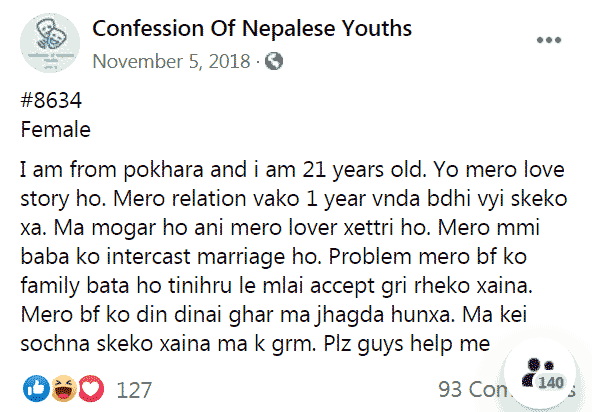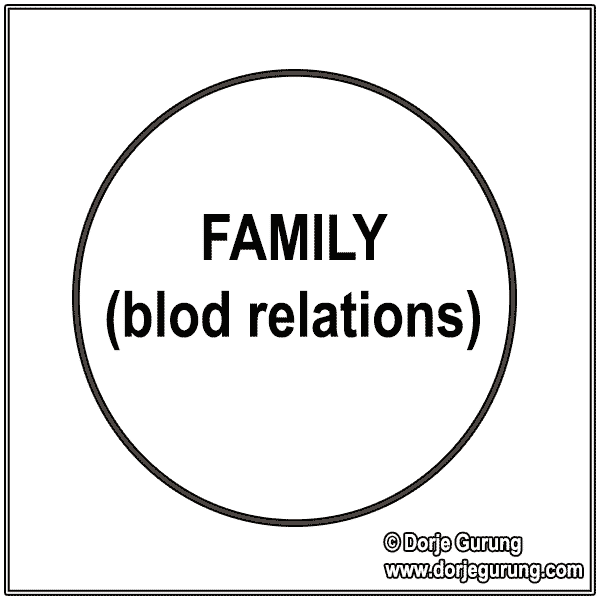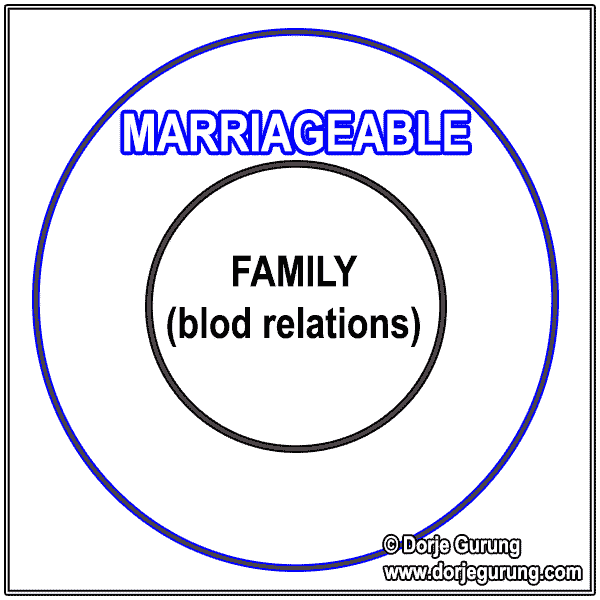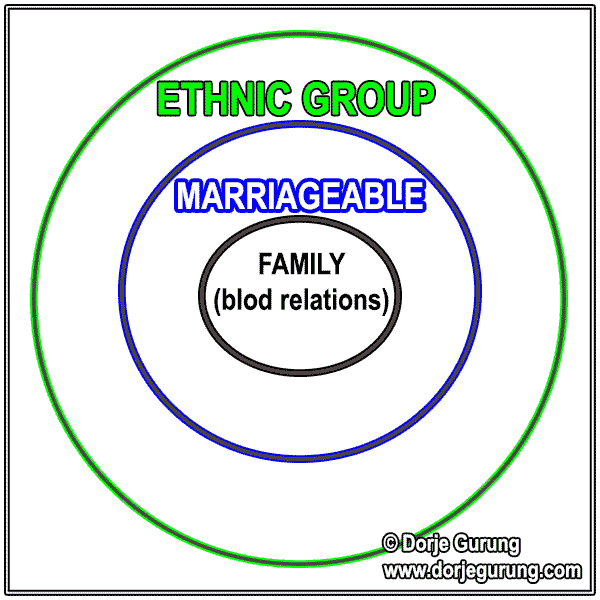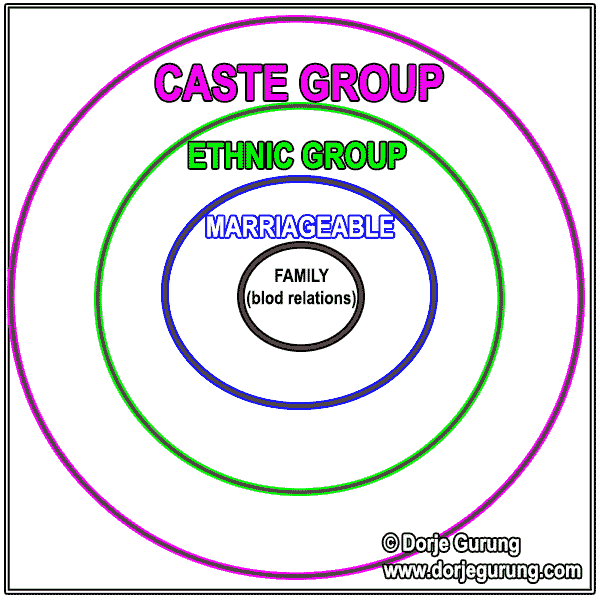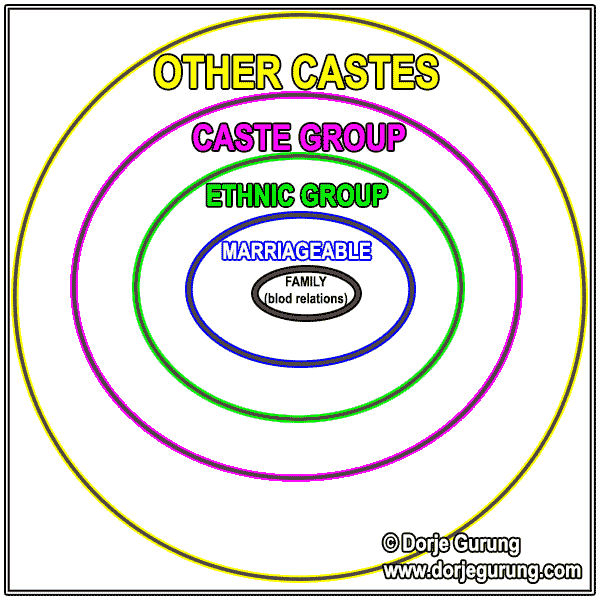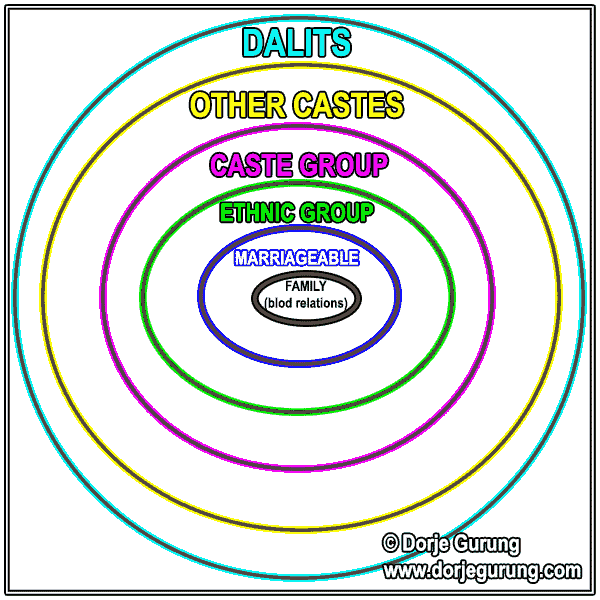A confession from a Facebook confession page.
It reads thus:
I am from Pokhara and I am 21 years old. This is my love story. I have been in a relationship for over a year now. I am a Magar [one of the lower castes,] and my lover is Chhetri [a hill so-called high caste Hindu]. My parents are an inter-caste couple. The problem is with my boyfriend’s family not accepting me. My boyfriend has arguments with his family every single day over our relationship. I can’t decide what to do. Please guys help me.
The above story is not really that unusual. In दलित मुद्दामा किन नजाग्ने आदिवासी-जनजाति ? (“Why the indigenous Nepalis should champion Dalit causes”), Tashi Tewa analyzes and identifies cases of human rights violations around inter-caste marriages between 2003 and 2013.
Even the extreme — murder — has also been committed over inter-caste relationships. One of the most heinous of caste-based hate-crimes in recent memory, the lynching of half a dozen Dalit young men just last May in Rukum District, was triggered by inter-caste relationship and question of marriage. Nabaraj and five friends were mercilessly beaten to death by a mob of villagers and their bodies — with hands tied behind their backs — dumped into a river.
Their “crime”? Nabaraj daring to love and seek the hand in marriage of a so-called high caste girl.
We in Nepal are able to do that because our social circles consist of people found within pretty well-defined — albeit not completely rigid and impermeable — concentric circles, driven mainly by the caste system (see image below).
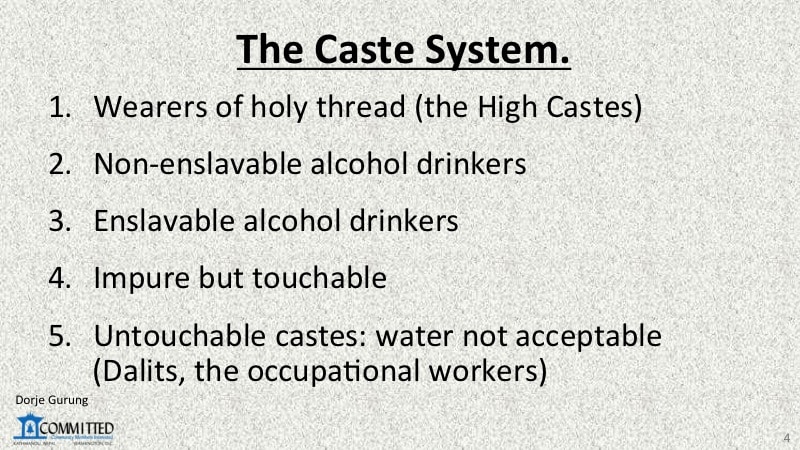
In a series of blogs starting with this, I shall be describing and explaining how the insidious and pernicious monstrosity of the caste system ensures Nepalis live and move within exclusionary small and limited social bubbles as well as how and why that in turn gives rise to such gross violations of many such rights in the country. In this one I shall describe the structure of Nepali communities with the help of some visual aids.
Valuing groupism significantly more over individualism, the central — the most important and valued — functional unit in Nepali society is the family, the extended family. Family is considerably more important than the individual. So, the most important people for a Nepali are her/his blood relations (see image below).
In the second circle are “marriageable” people (see image).
These are people from among whom the family could — or really should — pick a life partner for their children. In other words, within this circle are people the social system and therefore the society has sanctioned — that is, requires and approves of — the family establishing a familial alliance with.
That is not to say that every member of that network — everyone between the boundaries of the inner and the second circle — are part of an individual’s daily life or even occasional part of their life. Some or even many within the inner circle might not even be aware of the existence of some or even many members of “marriageable” network, especially if they happen to live in a different part of the country.
It’s not unheard of for two families to agree to marry off their children because “everything fits” though, without the children even having met each other. Majority of the marriages in Nepal are arranged either by the immediate families themselves or through a system involving relatives and/or middle-men — people for whom that’s actually a job and have titles! Lami, for instance, is one such title!
Outside the second and within the third circle (see image below) fall the rest of the members of ones ethnic group. If you are a Newar, the rest of the Newars. If you are a Gurung, the rest of the Gurungs etc. (Incidentally, contrary to what my surname indicates, I am NOT a Gurung.)
Not all within one’s ethnic group are marriageable for different reasons in different ethnic groups and castes. One reason for non-marriageability is also actually Scientific: patrilineage! That, and in some other ways too, members of one’s ethnic group are distinguished from one another.
Self-segregation driven by expectations and pressure from the society and reinforced by members of the two inner circles help maintain the above division. In where we live, who we choose to socialize with at functions and events etc., Nepalis self-segregate along not only caste lines as well as status and hierarchy within the caste, but also class (which parallels caste, mostly), gender, and age brackets as well. Obviously, there’s more to that but it will have to wait until the follow-up blogs.
When it comes to marriage and establishing a family-to-family alliance, what all that boils down to is that even within an ethnicity, the chances of a higher status family asking a lower status family for their child’s hand in marriage to theirs, or vice versa, is low to non-existent. That is NOT to say that marriage between individuals of the same ethnicity but from different social strata does NOT happen at all. It does and when it does it’s usually “love marriage.” (Love marriage is in quotes because the denotation of the term in Nepanglish is considerably broader than in English.)
(I don’t know of any reliable data about the different rates of arranged vs. love marriage however, though, I am sure arranged marriage vastly out-number love marriage. An interesting study could be about that and the reasons for individual’s choices of one or the other form of marriage.)
Outside the third circle and within the fourth are people who belong to their own caste (see image).
Outside that and within the fifth circle are those who belong to other castes (see image).
To reiterate: the boundaries of the third and fourth circles might not be as “solid” and “impenetrable” in reality. For some individuals, the boundary might be so porous that some who belong to their caste actually might be part of the third circle.
Regardless, more often than not, people within the fourth circle would be their OTHER friends, their OTHER colleagues, their OTHER acquaintances etc. Generally when we Nepalis talk about “us” and “them,” the “them” are people who belong to other castes — everyone who falls outside the fourth circle.
They would be people one would not as readily or easily align with or show allegiance to as one would those within the third or fourth circles; people one would hesitate to introduce family members to at public social gatherings or functions (such as weddings); people one would hesitate to invite home for meals or to family functions as readily; people one would not gossip about with members of the inner circle etc.
Doing any of that makes oneself and those in the inner circle uncomfortable. Those in the two inner circles might, for example, have uncomfortable questions that one might have the answers to but doesn’t want to have a discussion over in order to maintain (the apparent) harmony within the family and/or community! Nepalis hate feeling or making others uncomfortable, whether socially, emotionally, or intellectually. Exceptions exist of course!
The Dalits would fall outside the fourth circle (see image).
For a dramatic visual confirmation of that, just visit settlements in the countryside, where a little over 80% of Nepalis live. Dalits in a village live separately from everyone else, in addition to eating separately at community, social, and other public functions and gatherings etc. Of course, not by choice but by generation upon generation of enforcement and marginalization. Or, if you go to the Southern Plains, my understanding is that they are isolated in little communities of their own with no or minimum services, like water, electricity etc. Many don’t even carry citizenship papers!
Were I to make such a visual representation for an average Dalit family, it would consist of just three circles: family, marriageable, and other Dalits.
To point out something obvious, the size of the circles as well as the rigidity and permeability of those boundaries varies from one person to another. To begin with, obviously, it depends a lot on the individual — their personality, their level of education, their life choices and experiences.
Something else that’s obvious is that, for an individual, the caste one is born into also hugely impacts the size of the circles. Clearly, the network and therefore the size of the circles for a hill so-called high caste Hindu — being born into privilege and therefore into a context of high social capital — is likely be the biggest on average. A Dalit’s social circle and network, on average, will be the smallest of all castes.
Other factors which likely affect the size of the circles are gender, age, and financial worth. On average, a woman’s social circle and professional network will be much smaller than that of a man’s.
To reiterate for the third time, the boundaries of the circles are permeable! However, not as much as they ideally should be to contribute towards the establishment of a just and equitable society any time soon (about which I’ll have more to say in the follow-up blog posts). The individuals in the two inner circles and society tightly controls the permeability of the boundaries.
In other words, how big or small a Nepali wants their circle to be or whether to even eliminate some of those boundaries is in their as well as their community’s hands. But our caste-inculcated social values, caste-influenced systems and structures are such that a Nepali values allegiance to, membership in, and maintenance of the integrity of the three inner circles more than breaking the boundaries and allowing others beyond those circles in. Family, after all, is the fundamental unit in our society!
The groupism we have in Nepal — as you may have now realized — is, sadly, in some ways more akin to the kind of tribalism one would have found during the hunter-gatherer phase of our evolution! Don’t you think?
What do you think?
(This blog actually started out as a tweet thread. Click here for it. Where do the internationals fall in this structure? Depends. Read about it here.)
References
- An independent journalist, Salokya has produced an excellent series of articles in his Nepali medium blog My Sansar about the incident in Rukum and subsequent issues. Click here, here, here, here, here, here, and here.
- The Record also published two articles on the subject. Click here and here for them.
The following were added after the publication of the blog for their relevance.
- The Kathmandu Post (Aug. 12, 2020). Us and them. “If in terms of sharing state power, access to state institutions through appointments and career opportunities become the crux of the problem, socially speaking, it’s the marital relations that make the ‘us and them’ division astute.” [Added Aug. 14, 2020.]
- Bennett, Lynn, Dilli Ram Dahal and Pav Govindasamy, 2008. Caste, Ethnic and Regional Identity in Nepal: Further Analysis of the 2006 Nepal Demographic and Health Survey. Calverton, Maryland, USA: Macro International Inc. [Added Jan. 17, 2021.]
- SetoPati (July 16, 2021). ३५ सय वर्षको जातपातको इतिहास (भिडिओ र रिपोर्टाज) Excellent interview with Aahuti about the history of the Caste System in Nepal going as far back as 3.5K years!! [Added on July 19, 2021.]

